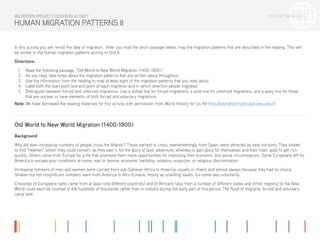
Lesson 8.1 Activity: Human Migration Patterns II
- 1. STUDENT MATERIALS HUMAN MIGRATION PATTERNS II In this activity you will revisit the idea of migration. After you read the short passage below, map the migration patterns that are described in the reading. This will be similar to the human migration patterns activity in Unit 6. Directions: 1. Read the following passage, “Old World to New World Migration (1400–1800).” 2. As you read, take notes about the migration patterns that are written about throughout. 3. Use the information from the reading to map at least eight of the migration patterns that you read about. 4. Label both the start point and end point of each migration and in which direction people migrated. 5. Distinguish between forced and unforced migrations. Use a dotted line for forced migrations, a solid line for unforced migrations, and a wavy line for those that are unclear or have elements of both forced and voluntary migrations. Note: We have borrowed the reading materials for this activity with permission from World History for Us All (http://worldhistoryforusall.sdsu.edu/). Old World to New World Migration (1400-1800) Background Why did ever-increasing numbers of people cross the Atlantic? Those earliest to cross, overwhelmingly from Spain, were attracted by new horizons. They looked to find “heathen” whom they could convert, as they saw it, for the glory of God; adventure, whereby to gain glory for themselves and their ruler; gold, to get rich quickly. Others came from Europe for a life that promised them more opportunities for improving their economic and social circumstances. Some Europeans left for America to escape poor conditions at home: war or famine, economic hardship, isolation, suspicion, or religious discrimination. Increasing numbers of men and women were carried from sub-Saharan Africa to America, usually in chains and almost always because they had no choice. Smaller but not insignificant numbers went from America to Afro-Eurasia, mostly as unwilling slaves, but some also voluntarily. Crossings of Europeans (who came from at least nine different countries) and of Africans (also from a number of different states and ethnic regions) to the New World could each be counted in the hundreds of thousands rather than in millions during the early part of this period. The flood of migrants, forced and voluntary, came later. BIG HISTORY PROJECT / LESSON 8.1 ACTIVITY
- 2. STUDENT MATERIALS HUMAN MIGRATION PATTERNS II European Migration: Mostly voluntary crossings (east to west and west to east) In the beginning, Europeans did not flock eagerly to the Americas. By 1570, there were still only some 140,000 of them in Spanish and Portuguese America. Between 1500 and 1800, about 2 million Europeans traveled to the Western Hemisphere. Europeans, however, still constituted a minority of the population in most parts of the Americas as late as 1800. It was only later in the nineteenth century that the influx of Europeans to the Americas really took off. Some Europeans who arrived in the Americas were convicts, their passage forced. Many British and French immigrants arrived as indentured servants. That is, they were bound by a legal contract to serve their employer without pay for a number of years, typically four to ten, in return for having their passage paid and their housing and food provided during their indenture. Their lives in the New World might be just as bad as in their home countries, unfortunately. They had little protection from being poorly fed and worked to excess, or from dying of neglect when they were sick. Spanish law forbade non-Spaniards from settling in their American territories. But in North America between 1600 and 1650, Finns, Swedes, German Protestants, Jews, and Danes, as well as the British, French, and Dutch established settlements. Native American Migration: Forced crossings (west to east) and forced migrations within the Americas Starting only a few years after Columbus’s first voyage, many Native Americans were sold in Spain and Portugal as slaves. Although we can’t be certain about the number of Native Americans affected, we do know that tens of thousands of them were transported as slaves from one part of America to another. African Migration: Forced crossings (east to west) Both the Spanish and the Portuguese were familiar with slavery in their home countries. At the start of the sixteenth century, both had substantial populations of slaves from North Africa and West Africa. Some were captured in raids, but most were bought. In 1550, there were about 9,000 African slaves in Lisbon doing a variety of jobs in government offices, hospitals, noble households, craft shops, and on farms. There were also some white slaves from the Caucasus, as well as Slavs and Turks. It is in this time period that the African slave trade, the forced migration of millions of African men and women across the Atlantic, emerged. Between 1450 and 1810, as many as 11 million enslaved Africans arrived in the Americas. European sea merchants contracted with African rulers and traders to sell them captured Africans who had been enslaved by fellow Africans in their homelands. Historians have estimated that 42 percent of these enslaved men and women were sent to the Caribbean, 38 percent to Brazil, and only 5 percent to North America. Between 1500 and 1800, the proportion of men and women of African origin in the Americas steadily grew. BIG HISTORY PROJECT / LESSON 8.1 ACTIVITY
- 3. Name: Date: STUDENT MATERIALS HUMAN MIGRATION PATTERNS II Directions: Map the migration patterns that occurred from 1400-1800. BIG HISTORY PROJECT / LESSON 8.1 ACTIVITY
- 4. TEACHER MATERIALS HUMAN MIGRATION PATTERNS II (ANSWER KEY) Directions: Map the migration patterns that occurred from 1400-1800. BIG HISTORY PROJECT / LESSON 8.1 ACTIVITY AMERICAS SPANISH AMERICA AFRO-EURASIA EUROPE NORTH AFRICA Legend Migration routes (voluntary) Migration routes (forced) Migration routes (mixed) WEST AFRICA PORTUGUESE AMERICA
